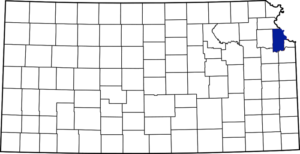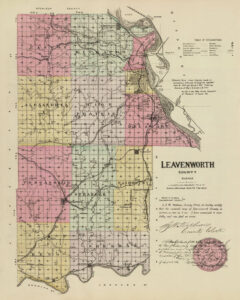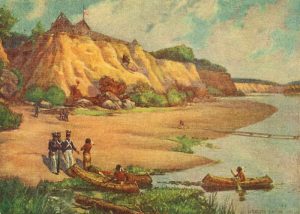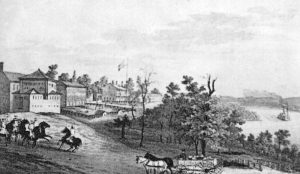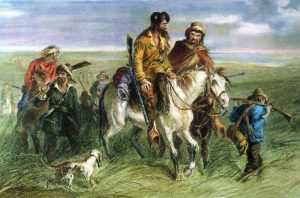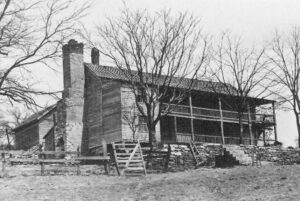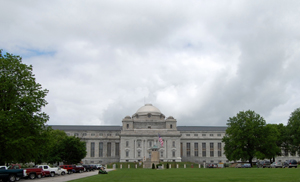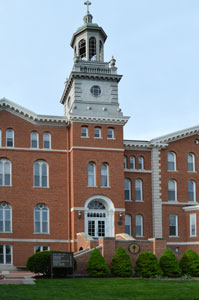Basehor
Easton
Jarbalo – Unincorporated
Kansas State Penitentiary
Lansing
Leavenworth – County Seat
Linwood
Tonganoxie
United States Penitentiary
In the northeastern part of the state, Leavenworth County, Kansas, is in the third tier of counties south of Nebraska and the first west of the Missouri River. The first territorial legislature established the city in 1855.
Initially, Leavenworth County embraced the present county and present Wyandotte County, which was detached and established as a separate county in 1859. It was named in honor of General Henry Leavenworth, an officer in the United States Army. The county is bounded on the north by Atchison County; on the east by Wyandotte County and the Missouri River, which separates it from Missouri; on the south by Wyandotte, Johnson, and Douglas Counties; and on the west by Douglas and Jefferson. It has an area of 455 square miles.
In the eastern portion, along the Missouri River, the land is broken and hilly, but the western and southwestern portions are rolling prairie. The river and creek valleys average from a half-mile to a mile and a half in width and comprise about one-fourth of the area. The uplands are sparsely wooded, and artificial groves have been planted everywhere. Timber belts along the streams contain all varieties of trees native to Kansas. The principal water courses are the Missouri and Kansas Rivers. Little Stranger, Tonganoxie, Nine Mile, Salt, Wolf, and Kaw are the most significant tributary creeks.
The Land where Leavenworth and Fort Leavenworth are located today was originally inhabited by the Kanza, Osage, and Delaware Indians. Today, many streets are named after these and other local Indian tribes.
The French traders and explorers who came up the Missouri River early in the 18th century were the first whites to visit Leavenworth County. The first European settlement in the area was Fort de Cavagnial, built in 1744. Named for its founder, François-Pierre Rigaud, Baron de Cavagnial, French governor of Louisiana, the fort served as a trade center between French traders, soldiers, and Kanza and other native peoples.
A Jesuit mission was established on the Missouri River in what is now Leavenworth County, making it the first mission in what is now the State of Kansas. By 1757, the Missouri River route to the west was known to the French voyageurs, and fleets of boats came down the river each spring laden with furs bought from the Indians at the headwaters.
In the spring of 1827, Colonel Henry H. Leavenworth was directed to ascend the Missouri River and select a site for a permanent post. He soon chose a site on the river bluffs, and this would become Fort Leavenworth. It was established to protect those on the Santa Fe Trail from the dangers of Indian attacks. A building at Fort Leavenworth was the first capital of Kansas. Fort Leavenworth played an essential role in maintaining peace among various Indian tribes and in the face of the increasing number of settlers heading west over the next several decades. It also served as a supply base, Headquarters of the Upper Missouri Indian Agency, and operations base during the Mexican-American War.
In 1833, a Methodist mission was established in what is now the northeastern part of Leavenworth County, and the following year, the Catholic Church established a manual labor school for the Indians in Kickapoo Township. However, they did not take kindly to work, and it was abandoned. Outside the fort, the missionaries were the first to locate permanently.
By the 1840s, travel to Oregon and California had begun, and thousands of wagons passed through Leavenworth on the way to the Santa Fe and Oregon Trails.
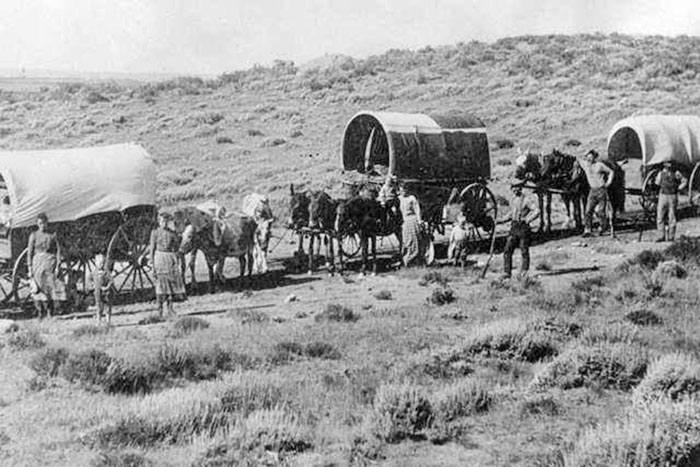
Wagon Train.
In 1844 Major Robert Wilson established a trading post in Salt Creek Valley, but he sold out in 1852. The first white settlers in Leavenworth County who had any legal right to locate within the territory were the farmers who came to cultivate the lands on the military reservation and the missionaries of the immigrant Indians.
In 1851 the Catholic diocese of Leavenworth created a mission. The first mass was said in the county in 1854.
The Delaware Trust Lands were part of Leavenworth County, and in the early years, many claimed land there. This led to many “squatters” claiming their land but lacking the legal right to it. They still fought for their claims despite knowing they were in the wrong.
When Kansas was opened to white settlers, pro-slavery residents of Platte and other Missouri Counties, who favored the establishment of slavery in Kansas, knew of the rich and valuable land held by the Indians just across the line and only waited for its cession to come in and take claims. When the treaties were made, they did not wait to learn the terms of the land sale but rushed across the river and staked out claims. So great was this influx that by the close of June 1854, there was scarcely any land that settlers from across the border had not claimed. The first land claimed after the passage of the Kansas-Nebraska Act in 1854 was in Leavenworth County, where the present city of Leavenworth stands. On June 10, 1854, the squatters who had taken claims near the fort in Salt Creek Valley held the first “squatter meeting” in the territory. Two squatters’ associations- the Leavenworth County and the Kansas-Delaware Association- were formed to prevent non-residents from taking up land. At one of the meetings, a disagreement arose between McCrea, who had a claim near the fort but not on the trust land, and Clark. This led to a fight in which McCrea shot Clark, who soon died. The pro-slavery men claimed that William Phillips handed McCrea the revolver, and he was ordered to leave the county. When he did not leave, a vigilance committee, after warning him, took him to Weston, Missouri, tarred and feathered him, and rode him through the streets on a rail. This was the first clash between the Free State and pro-slavery factions, but it did not deter settlers from entering the county and making permanent homes.
In 1854, the City of Leavenworth was founded as the state’s first city. Leavenworth became nationally known as the “jumping-off point” for the opening of the West. Buffalo Bill Cody spent part of his youth here and later worked in the area as a Pony Express rider and Army scout. Cody’s parents are buried in Leavenworth.
The Herald was the first newspaper in Leavenworth County and the territory, issued on September 15, 1854.
Kansas’ territorial years were the source of much fighting and violence as the issue of slavery in the state was fought out, giving it the term “Bleeding Kansas.” Pro-slavery individuals controlled the city of Leavenworth, and Free-Staters were not welcome. Pro-slavery individuals also did not want Free-Staters traveling between Leavenworth and Lawrence, and armed men worked to keep Free-Staters from arriving along the river. Due to measures taken by the governor and mayor of Leavenworth, it became slightly calmer in October 1856.
In the meantime, the Presbyterians organized a church in January 1856. I was the first church of this denomination in the state.
Several prominent Free-State men of Leavenworth County were arrested on various charges and ordered to leave the territory. On May 31, 1856, a meeting was called at Leavenworth, at which a vigilance committee of pro-slavery men was appointed to notify some of the most active Free-State advocates to leave the territory. However, Governor Wilson Shannon’s proclamation ordering all committees organized to drive settlers out of the territory to disband broke up the Leavenworth County committee.
However, a band of regulators was formed under Frederick Emery’s leadership, and a reign of terror began again. Armed men patrolled the river and turned back boats that brought suspected Free-State immigrants. The road from Leavenworth to Lawrence became known as “The Devil’s Highway,” and some of the pro-slavery men vowed that no Free-State settler could travel on it between the two towns. Reverend Ephraim Nute, the Unitarian minister of Lawrence, John Wilder, a merchant of Lawrence, and Mrs. Hoope were taken on the road, and the men were held as prisoners of war, but the woman was allowed to go down the river. The “Regulators” under Emery killed William Phillips in the name of “law and order,” entered the homes and stores of Free-State men, and turned them out of doors. Many citizens were placed on board vessels bound for St. Louis and other points down the river. When Governor John Geary arrived, he quickly put a stop to the regulators’ actions. From this time, oppression and cruelty because of politics began to die in the county. However, hostilities persisted in the city of Leavenworth until violent measures were used to bring about peace.
The first session of the territorial legislature was organized in Leavenworth County. When the commissioners met, Governor Horatio Reeder had been removed, and the commissions of John A. Halderman as probate judge, Joseph M. Hall of Leavenworth, and Matthew R. Walker of Wyandotte were signed by Daniel Woodson, the acting governor. The board’s first meeting was held on September 7, 1856, at Lewis Rees’s warehouse in Leavenworth. James M. Lyle was appointed clerk of the board, ex officio recorder, and probate court clerk. At this meeting, the commissioners divided the county into Kickapoo, Delaware, Leavenworth, Alexandria, and Wyandotte Townships. They also appointed M. P. Rively, treasurer; L. T. Moore, assessor; Bennett Burnham, surveyor; Green D. Todd, sheriff; and James Blake, coroner. The constables and justices of the peace were appointed within a short time, and the county was thus permanently organized. No town had been named the county seat, and the board appointed A. Dawson, Martin Hefferlin, and Samuel El. Burgess holds an election on the second Monday in October to decide on a permanent location.
Eight miles above Leavenworth was Kickapoo City, a substantial pro-slavery settlement, and six miles down the river was Delaware City, a flourishing community with many advantages to offer. The election was a hard-fought, triangular contest over the location of the county seat. Pro-slavery voters were imported from Missouri to Kickapoo and Delaware. Kickapoo won, and when this was learned, Delaware City opened the polls a second day, resulting in the most votes being cast for Delaware. A legal contest followed with a decision in favor of Delaware. A two-room county building was erected, and the county offices were removed there on February 20, 1857. Still, the town’s triumph was short-lived, as the legislature of 1857 ordered a new election, at which Kickapoo City received a majority of the votes cast. Leavenworth petitioned to have the Kickapoo votes declared illegal because the voters had not been confined to the county. It was finally decided that Leavenworth received the most legal votes and was declared the county seat.
Jeremiah Clark donated land for the courthouse square, which was accepted. This was the east half of “Block 13.” The county purchased the other half for $13,000, and $35,000 worth of county bonds were voted for the erection of county buildings. However, the county offices were located in the city hall for many years, and it was not until 1873 that the courthouse was erected. It is estimated that the entire cost of the county buildings, when completed, was $175,000.
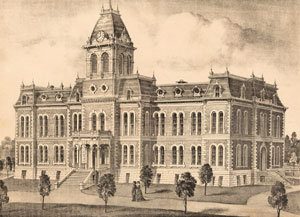
Leavenworth County, Kansas Courthouse, 1873.
In 1858, the Sisters of Charity of Leavenworth settled in Leavenworth.
The first school districts were established in 1858, with George E. Budington as superintendent. The first school in Leavenworth and also in the county is supposed to have been started in May 1855 by Reverend J. B. McAfee, who purchased a small building near the levee for religious purposes.
By 1860, Leavenworth County’s population was 12,606.
In May 1860, a tract of 200 acres of land was purchased about four miles southwest of Leavenworth for a county poor farm, on which a county house and contagious hospital were erected, the entire property valued at over $12,000.
At the opening of the Civil War, both the city and county of Leavenworth were better populated than many of the towns and counties of Kansas, which lay to the west, and it was but natural that many troops should be raised. Union men and their families who had resided in the border counties of Missouri came in considerable numbers to Leavenworth for protection, swelling the ranks of the volunteers. Many leaders gained a name for bravery and courage during the great conflict called Leavenworth home. By May 1861, eighteen companies were organized. Afterward, more companies were raised: Kickapoo Guards, Black’s Guards, Leavenworth Mercantile Guards, Leavenworth Light Cavalry, Lyon Guards, Third Ward Guards, Fourth Ward Guards, Old Guard, and the Union Guards (cavalry). Fort Leavenworth was critical during the war, and Confederate General Sterling Price even targeted it during an 1864 raid.

Kansas State Penitentiary
In 1863, the legislature passed an act to erect the Kansas State Penitentiary on a site in Lansing. The contract to build the prison was made in 1863, and work started in 1864. However, due to financial difficulties related to the Civil War, work stopped in 1864 and did not resume until 1866. The building was first occupied in 1868.
The Kansas Pacific Railroad was started at Wyandotte in 1863 and was completed to Denver, Colorado, within two years. Leavenworth became one of the terminals. This began a new era of railroad construction, and afterward several railroads were built in the county, providing transportation and shipping facilities. These included the main line of the Union Pacific Railroad, three lines of the Atchison, Topeka & Santa Fe Railroad, a line of the Missouri Pacific Railroad from Kansas City, the Leavenworth, Kansas & Western, and a branch of the Missouri Pacific, which entered the county on the east and crossed west into Jefferson County, and the Chicago, Burlington & Quincy Railroad. The Kansas City & Leavenworth electric railway ran southeast from Leavenworth, connecting the two cities.
In 1864, the Sisters of Charity of Leavenworth opened St. John Hospital.
The Federal military prison was built on the Fort Leavenworth military reservation in 1874, and the Federal Prison for offenders against the laws of the United States is also located there. The National Home for Disabled Volunteer Soldiers is situated on a beautiful site of ground south of the city of Leavenworth. In the vicinity of the home, a large city called National Military Home grew up.
In 1881, the school that later became the U.S. Army Command and General Staff College was founded on Fort Leavenworth by General William T. Sherman. Some of the many famous students and instructors at the college were George C. Marshall, Dwight D. Eisenhower, Douglas MacArthur, George Patton, and Colin Powell.
In 1885, the Wadsworth Old Soldiers Home was built and later became the Veterans Administration Center.
By 1900, 40,940 people were living in Leavenworth County.
In 1906, the first cellhouse at the Leavenworth Federal Penitentiary was opened. Among the infamous criminals incarcerated were Carl Panzram, Machine Gun Kelly, and Robert Stroud, the Birdman of Alcatraz. This imposing facility took over 11 years to complete.
In the spring of 1911, the courthouse in Leavenworth burned, and the county offices were temporarily located in business blocks until a new county building was provided. The county’s population in 1910 was 41,207.
At that time, the county was in the front rank in producing Irish potatoes and sorghum. Winter wheat, corn, oats, and hay were also extensively raised. There were over 300,000 fruit trees of bearing age in the county, and it ranked high in livestock raising. Limestone and sandstone for the building were abundant and extensively quarried near Leavenworth. Gray limestone was found in the bluffs, and blue limestone on the lower lands. Red and yellow ocher existed south of the city of Leavenworth; in the west and southwest, cement rock of good quality was plentiful; potter’s clay was common in several localities; a significant part of the county was underlaid with a bed of coal, which had for many years been mined at Leavenworth and the state penitentiary at Lansing.
Sisters of Charity of Leavenworth founded Saint Mary College in 1923, now the University of Saint Mary.
Today, several properties in Leavenworth County are listed on the National and State Registers. These include the Abernathy Furniture Company Factory, a critical Leavenworth business. James Abernathy started his Leavenworth furniture business in 1856 and eventually grew it into a successful furniture manufacturing company. The David J. Brewer House was the house of Brewer, who held many public offices, from the president of the Leavenworth Board of Education to serving on the Kansas Supreme Court, the U.S. Eighth Circuit, and the U. S. Supreme Court. The Hollywood Theater, designed by Robert Boller, was built in the 1930s. The Leavenworth County Courthouse was built in 1911-1913 after the previous courthouse was destroyed by fire. The Fred Harvey House, one of the Chain restaurants started by Fred Harvey, who was from Leavenworth, was built around 1875. The county also contains two National Historic Landmarks. Fort Leavenworth and the Western Branch National Home for Disabled Volunteer Soldiers, now the Department of Veteran Affairs, Dwight D. Eisenhower Medical Center. It was founded in the 1880s.
As of the 2020 census, the county population was 81,881
©Kathy Alexander/Legends of Kansas, updated December 2025.
Also See:
Sources:
Blackmar, Frank W.; Kansas: A Cyclopedia of State History, Vol I; Standard Publishing Company, Chicago, IL 1912.
Cutler, William G.; History of Kansas; A. T. Andreas, Chicago, IL, 1883.
Kansapedia
Visit Leavenworth
Wikipedia


